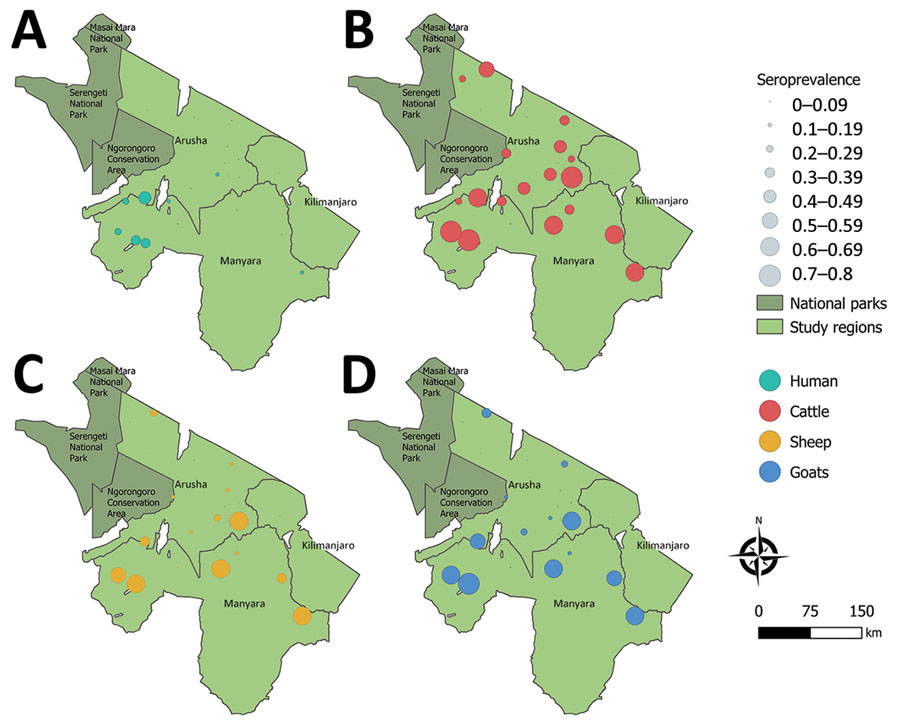Volume 30, Number 4—April 2024
Research Letter
Crimean-Congo Hemorrhagic Fever Virus Seroprevalence in Human and Livestock Populations, Northern Tanzania
Figure

Figure. Sampling area for study of seroprevalence of Crimean-Congo hemorrhagic fever virus in human and livestock populations, northern Tanzania. Circles indicates seroprevalence rates for humans (A), cattle (B), sheep (C), and goats (D). The pictured region is near Uganda, where human Crimean-Congo hemorrhagic fever cases have been documented (4).
References
- Bente DA, Forrester NL, Watts DM, McAuley AJ, Whitehouse CA, Bray M. Crimean-Congo hemorrhagic fever: history, epidemiology, pathogenesis, clinical syndrome and genetic diversity. Antiviral Res. 2013;100:159–89. DOIPubMedGoogle Scholar
- World Health Organization. Prioritizing diseases for research and development in emergency contexts [cited 2022 Feb 26]. https://www.who.int/activities/prioritizing-diseases-for-research-and-development-in-emergency-contexts
- Spengler JR, Bergeron É, Rollin PE. Seroepidemiological studies of Crimean-Congo hemorrhagic fever virus in domestic and wild animals. PLoS Negl Trop Dis. 2016;10:
e0004210 . DOIPubMedGoogle Scholar - Balinandi S, von Brömssen C, Tumusiime A, Kyondo J, Kwon H, Monteil VM, et al. Serological and molecular study of Crimean-Congo Hemorrhagic Fever Virus in cattle from selected districts in Uganda. J Virol Methods. 2021;290:114075–114075. DOIPubMedGoogle Scholar
- Messina JP, Pigott DM, Golding N, Duda KA, Brownstein JS, Weiss DJ, et al. The global distribution of Crimean-Congo hemorrhagic fever. Trans R Soc Trop Med Hyg. 2015;109:503–13. DOIPubMedGoogle Scholar
- Herzog CM, de Glanville WA, Willett BJ, Kibona TJ, Cattadori IM, Kapur V, et al. Pastoral production is associated with increased peste des petits ruminants seroprevalence in northern Tanzania across sheep, goats and cattle. Epidemiol Infect. 2019;147:
e242 . DOIPubMedGoogle Scholar - Christova I, Panayotova E, Groschup MH, Trifonova I, Tchakarova S, Sas MA. High seroprevalence for Crimean-Congo haemorrhagic fever virus in ruminants in the absence of reported human cases in many regions of Bulgaria. Exp Appl Acarol. 2018;75:227–34. DOIPubMedGoogle Scholar
- Rugarabamu S, Mwanyika GO, Rumisha SF, Sindato C, Lim HY, Misinzo G, et al. Seroprevalence and associated risk factors of selected zoonotic viral hemorrhagic fevers in Tanzania. Int J Infect Dis. 2021;109:174–81. DOIPubMedGoogle Scholar
- Hoogstraal H. The pidemiology of tick-borne CCHF in Asia Europe and Africa. J Med Entomol. 1979;15:307–417. DOIPubMedGoogle Scholar
Page created: March 01, 2024
Page updated: March 21, 2024
Page reviewed: March 21, 2024
The conclusions, findings, and opinions expressed by authors contributing to this journal do not necessarily reflect the official position of the U.S. Department of Health and Human Services, the Public Health Service, the Centers for Disease Control and Prevention, or the authors' affiliated institutions. Use of trade names is for identification only and does not imply endorsement by any of the groups named above.